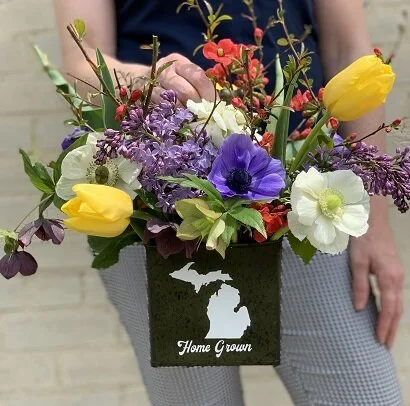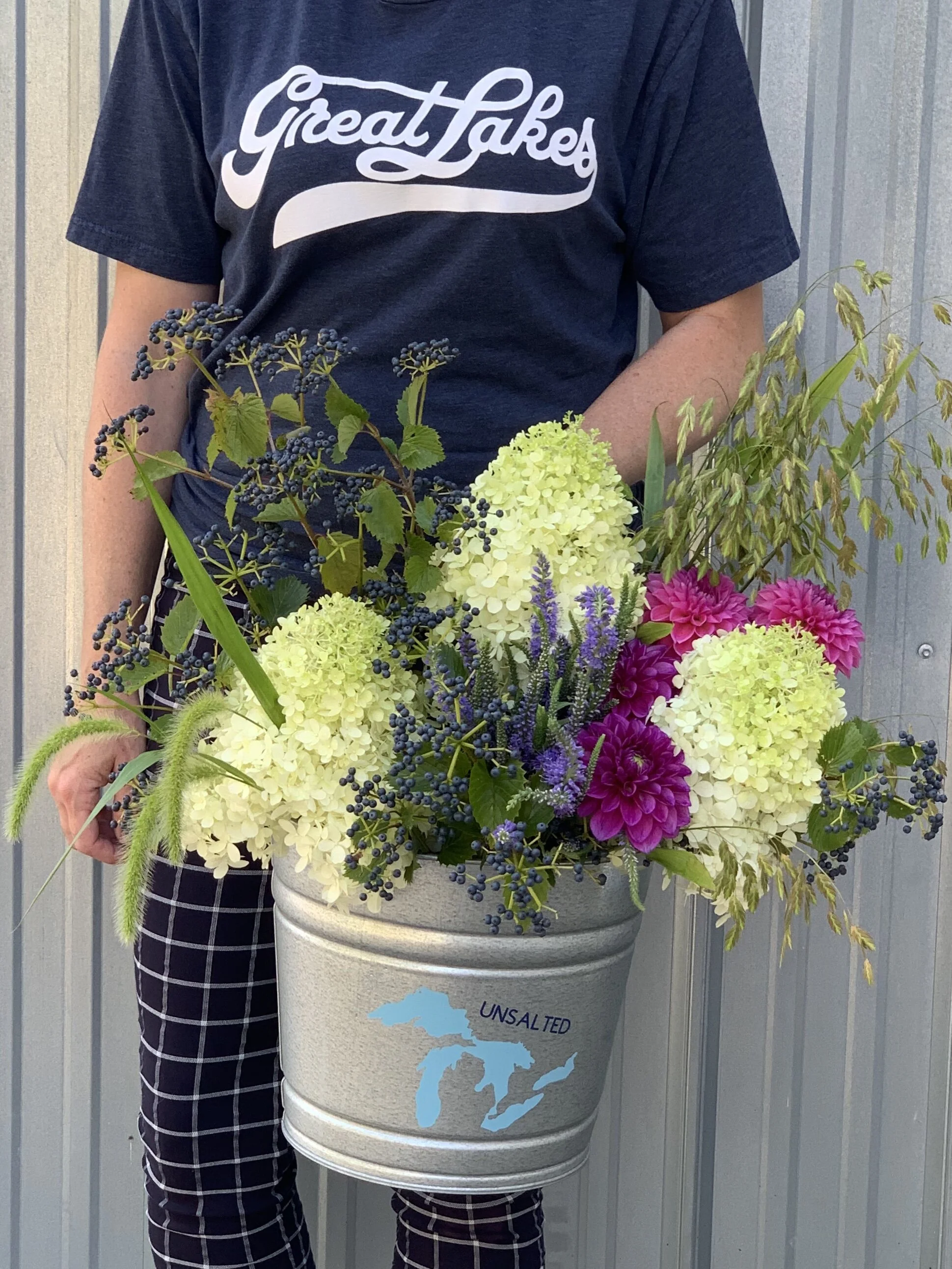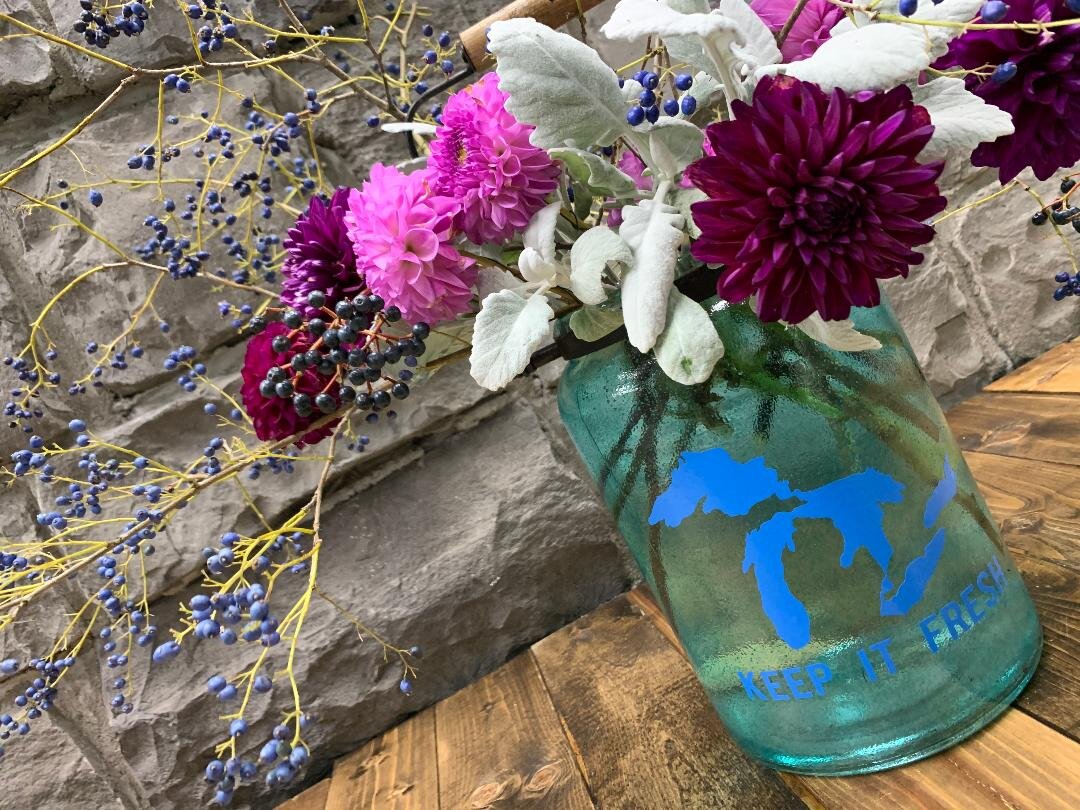Michigan Grown
““...my real emphasis is on the farmers who are taking care of the land, the farmers who are really thinking about our nourishment. And so I’m looking for them... to have ingredients that are grown in a place where they really thrive, and so you’re looking to the farmer to plant the right seeds in the right place and care for them and know when to pick them.””
Grown in Michigan custom jar with end-of-season blooms including hydrangea, dahlias, bittersweet, broomcorn, dusty miller, and foraged cuttings.
Since another Michigan growing season is drawing to a close, it seems like the perfect time to reflect on designing with local flowers. I’m an admirer of the aesthetic local flowers provide, and for me, designing with these blooms brings an arrangement to the next level. It’s not just the stems themselves that add this extra element, it’s the experience of knowing the full story, the answers to the 5 Ws.
In her book Slow Flowers, Debra Prinzing reflects on the joy of knowing the source of her flowers. “Having a relationship with the grower who planted and nurtured each flower is nothing short of magical… They are the unsung heroes – the face behind the flowers we love.” That’s the extra element, similar to the feeling of knowing the story behind the food we eat: intangible but valuable.
This floral design includes burgundy amaranth, dahlias, aster, blue viburnum, veronica, dusty miller, curly willow, and kiss-me-over-the-garden-gate. All the flowers were grown in Holland, Michigan, Montague, Michigan and Wyoming, Michigan. The custom wooden box uses the tag “Smitten with the Mitten.” This arrangement was designed in late August at Wyoming Stuyvesant Floral in Wyoming, Michigan.
Within this post I’ve included several images of arrangements we designed using only Michigan-grown flowers, specifically within 60 miles. Designing with the intent to focus solely on locally grown flowers, we couldn’t ignore the connected issue of sustainable practices. In addition to answering the where, we thought about the how. How could we create functional, deliverable flower designs using sustainable practices?
A growing consensus within floristry communities is to support a move to foam-free designs. There are lots of occasions where our reality includes floral foam, but there are cases where we use this product when there are other mechanic options. The option that gets the most play hearkens back to the days before floral foam existed: chicken wire. My mom will occasionally talk about how they used to use chicken wire to design large wedding arrangements and candelabra flowers. I used to think, I’m really glad I’ll never have to do that. But now, floristry is turning back to these old-school techniques as the industry moves towards reducing foam use. All of the designs in this post are designed foam-free, either just in water or using florist netting wire (chicken wire with green coating).
Ottawa Glad Growers - Holland, Michigan
Howard and Judy Lubbers from Ottawa Glad Growers in Holland, Michigan were doing Slow Flowers before it was a movement. They grow an incredibly diverse crop and operate year-round, which in Michigan, to put it mildly, is difficult. The winter months start out with evergreens, winterberry, red dogwood, curly willow, and birch and end with forced branches of forsythia and pussy willows. Early spring brings greenhouse-grown ranunculus, then more flowering branches from quince to apple to dogwood, and finally lilac. Once June hits, they have an abundance of peonies in hot pink, pink, and white followed by an endless variety of early summer blooms. Then as midsummer hits, everyone is waiting for the glads, sunflowers, and finally the dahlias.
Flowers on the refrigerated truck from Ottawa Glad Growers in Holland, Michigan. During the summer and fall, they stop twice per week. Early August availability on their truck included phlox, viburnum berry, sunflowers, gladiola, scabiosa, and allium.
Michigan-grown spring blooms including lilac, tulips, quince branches, hellebore, and anemones. These spring stems are arranged in a custom pail featuring the “Home Grown” tag with the Michigan mitten. Photo taken on May 17, 2019 at Wyoming Stuyvesant Floral in Wyoming, Michigan.
Ottawa Glad Growers stems including limelight hydrangea, oatgrass, foxtail millet, blue viburnum, veronica, and the beloved dahlia. August 30, 2019 at Wyoming Stuyvesant Floral.
Dahlias
I previously wrote a blog post about sunflowers (available here), so I won’t say too much about local sunflowers, but you can’t write about local flowers without including a section on dahlias. Dahlias do not ship well, so to have a beautiful dahlia it really does need to be locally grown. This particular bloom seems to be holding onto its seasonal status. We get the majority of our dahlias from the Lubbers, but this year Sally planted tubers in a cutting garden at my grandpa’s house, just minutes from the flower shop. She grew the gorgeous and often-coveted Cafe au Lait variety. They’re so colossally beautiful, but they have a mind of their own. The same variety may produce a pinky-mauve bloom or a peachy-champagne bloom.
Cafe au Lait dahlias from Sally’s cutting garden with burgundy amaranth, asters, and lisianthus from September’s Flowers in Montague, Michigan. Designed by Wyoming Stuyvesant Floral.
September’s Flowers
September Dykema, owner of September’s Flowers, is focused on growing local and sustainable fresh flowers on her farm in Montague, Michigan. This year Sally, Elizabeth, and I visited September’s U-cut fields one Sunday in August. It was so great to walk through her fields, to cut zinnias and cosmos, and to see the crops that were still to bloom.
Through September’s delivery service we purchased the most gorgeous lisianthus, amaranth, aster, dusty miller, and eucalyptus. The eucalyptus was other-worldly, so soft, fragrant, and of course, fresh. I can’t say enough about her amazingly strong and long-lasting lisianthus. (Check it out in the hand-held bouquet above.) She also introduced us to the magic of scented geranium. This foliage has the most pleasing fragrance. It reminded me of the joy of smelling a lavender rose in the 80s.
Our visit to September’s Flowers, August 2019.
Jennifer and Sally in the U-cut fields at September’s Flowers in Montague, Michigan.
Seasonality
There has been a push within the floral industry to “solve” seasonality. It was viewed as a problem that peonies weren’t available for a November wedding or that lilacs were only available during a two week window in the spring. So the industry adapted, chasing seasons around the globe and shipping across the ocean.
I get it. It’s great to tell a bride “yes.” It’s a relief to have products with year-round availability. As a brick and mortar shop, we wouldn’t properly function without the global flower market. But from a design prospective, using locally-grown, seasonal fresh flowers captures an aesthetic that’s difficult to achieve out of a box.
Designed by Wyoming Stuyvesant Floral on August 30, 2019 using local quinoa, lisianthus, celosia, red viburnum berries, dahlias, asters, and gomphrena.
Arrangement featured in September’s blog post, Sunflower Wedding. Bar-side flowers with hops vines and cones, lime light hydrangea, Michigan sunflowers, dahlias, foxtail millet, and oatgrass. Perfect for a wedding at a brewery. The hops variety is Cascade by Pure Mitten Hops in Coopersville, Michigan. Design by Wyoming Stuyvesant Floral.
Designed by Wyoming Stuyvesant Floral on October 9, 2019 with local dahlias, broomcorn, sorghum, celosia, gomphrena, cattails, and dusty miller.
Designed by Wyoming Stuyvesant Floral on October 9, 2019 with local sunflowers, amaranth, foxtail millet, oatgrass, dahlias, and sorghum.
Designed by Wyoming Stuyvesant Floral on October 29, 2019 using local dahlias, amaranth, hydrangea, hearts-a-bursting, and blue viburnum.
Designed by Wyoming Stuyvesant Floral on October 29, 2019 using local dahlias, copper amaranth, hydrangea, bittersweet, and broomcorn.
KEEP IT FRESH - Sapphire berries, blue viburnum, dahlias, and dusty miller - November 5, 2019 - Wyoming Stuyvesant Floral.
Designing exclusively with Michigan-grown flowers is not our everyday reality. To fulfill our commitments to our customers, to serve them with year-round consistency, we need to rely on the global market. But it’s important to us to use those local stems whenever possible, whether that be in a design that is intentional Michigan-grown, like the arrangements in this post, or a compilation of local and global, like the arrangement in my bio picture. That being said, the more customers asking for and selecting Michigan-grown flowers, the more stems we’ll be able to purchase from our local farmers. Something worth considering the next time you’re shopping for flowers.
Jennifer Schuitema
Co-Owner of Wyoming Stuyvesant Floral, Wyoming, Michigan
Third-generation florist working in the same location established by her grandparents. She’s worked in flower shops most of her life but only in earnest since 1998, when she graduated from Western Michigan University with a BBA. She lives in Grand Rapids, Michigan.























